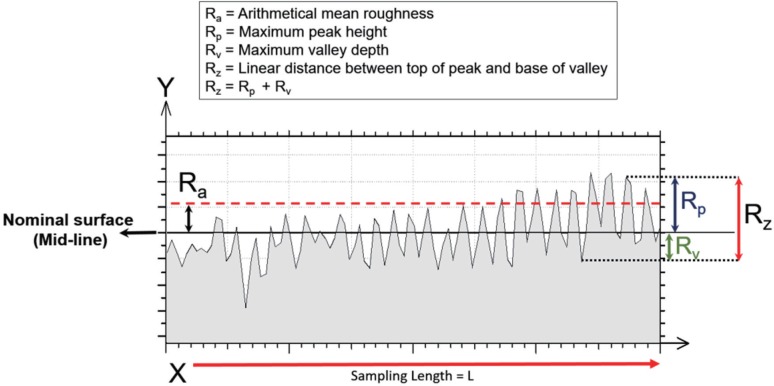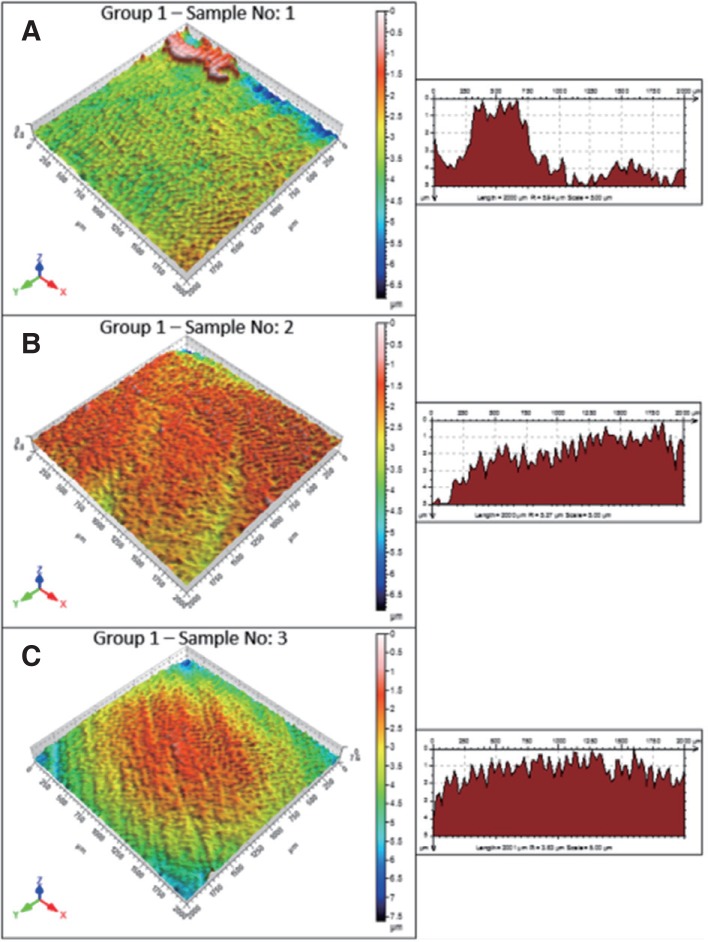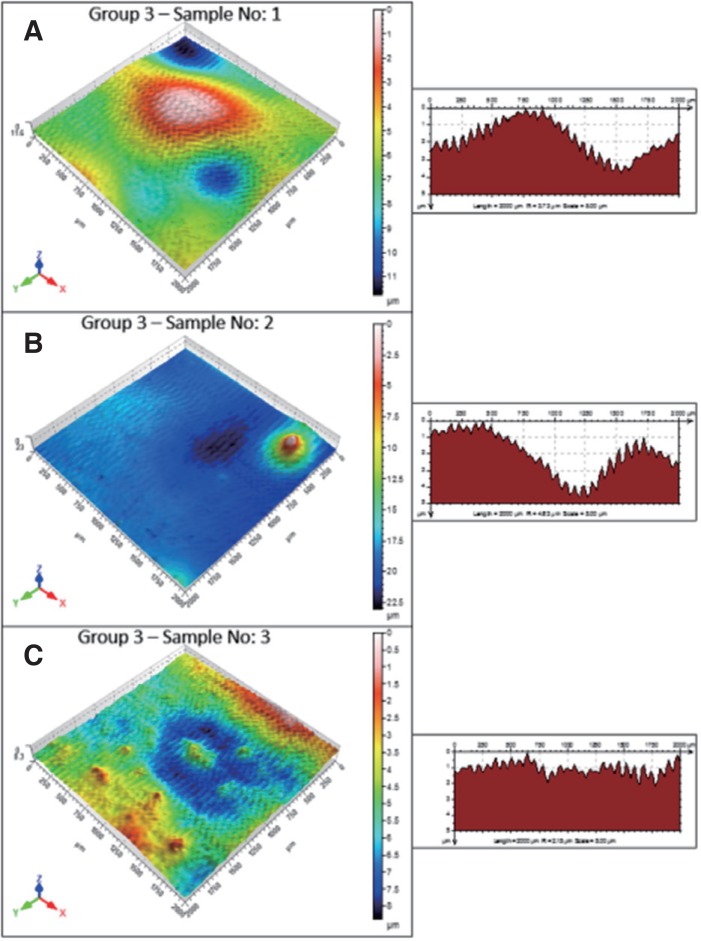J Adv Prosthodont.
2018 Feb;10(1):50-57. 10.4047/jap.2018.10.1.50.
The effect of glazing and aging on the surface properties of CAD/CAM resin blocks
- Affiliations
-
- 1Department of Restorative Dentistry, Faculty of Dentistry, Kocaeli University, Kocaeli, Turkey. neslihan_arslann@hotmail.com
- 2Department of Airframe & Powerplant, Faculty of Aeronautics and Astronautics, Kocaeli University, Kocaeli, Turkey.
- 3Department of Restorative Dentistry, Faculty of Dentistry, Istanbul University, Istanbul, Turkey.
- KMID: 2403998
- DOI: http://doi.org/10.4047/jap.2018.10.1.50
Abstract
- PURPOSE
To investigate the effect of accelerated aging on surface properties of glazed CAD/CAM resin blocks using a 2D surface profilometer and a 3D non-contact optical profilometer.
MATERIALS AND METHODS
Three types of CAD/CAM resin restorative materials, LAVA Ultimate (3M ESPE, St Paul, MN, USA), VITA Enamic (Vita Zahnfabrik H. Rauter, Bad Säckingen, Germany), and Cerasmart (GC Corparation, Tokyo, Japan) were used for this study. CAD/CAM blocks were cut in 3-mm thickness slabs and divided into three groups; Group 1: control group (specimens polished with 600 grit SCI paper); Group 2: specimens sandblasted, silanized, and glazed with Optiglaze Color (GC); Group 3: glazed specimens subjected to 5000 thermocycles (n=15). The surface roughness (Ra and Rz) was evaluated using a profilometer and a 3D scanning instrument. Data were analyzed using two-way ANOVA and Tukey's post-hoc test (P < .05).
RESULTS
LAVA, VITA, and Cerasmart exhibited statistically similar Ra and Rz values for each group (P>.05). For VITA and Cerasmart, the specimens in Group 1 exhibited significantly higher Ra values than Group 2 (P < .05). Group 1 (0.502 Ra), Group 2 (0.384 Ra), and Group 3 (0.431 Ra) exhibited statistically similar Ra values for LAVA (P=.062). After 5000 thermocycles, surface roughness values did not change significantly for glazed LAVA, VITA, and Cerasmart (P>.05).
CONCLUSION
Glaze material Optiglaze Color makes CAD/CAM resin surfaces smooth and glazed CAD/CAM surfaces seem resistant to deterioration under 5000 thermocycles.
MeSH Terms
Figure
Reference
-
1. Duret F, Preston JD. CAD/CAM imaging in dentistry. Curr Opin Dent. 1991; 1:150–154. PMID: 1777659.2. van Noort R. The future of dental devices is digital. Dent Mater. 2012; 28:3–12. PMID: 22119539.
Article3. Conrad HJ, Seong WJ, Pesun IJ. Current ceramic materials and systems with clinical recommendations: a systematic review. J Prosthet Dent. 2007; 98:389–404. PMID: 18021828.
Article4. Mainjot AK, Dupont NM, Oudkerk JC, Dewael TY, Sadoun MJ. From artisanal to CAD-CAM blocks: State of the art of indirect composites. J Dent Res. 2016; 95:487–495. PMID: 26933136.5. Ruse ND, Sadoun MJ. Resin-composite blocks for dental CAD/CAM applications. J Dent Res. 2014; 93:1232–1234. PMID: 25344335.
Article6. Coldea A, Swain MV, Thiel N. Mechanical properties of polymer-infiltrated-ceramic-network materials. Dent Mater. 2013; 29:419–426. PMID: 23410552.
Article7. Blatz MB. Long-term clinical success of all-ceramic posterior restorations. Quintessence Int. 2002; 33:415–426. PMID: 12073722.8. Kawai K, Urano M, Ebisu S. Effect of surface roughness of porcelain on adhesion of bacteria and their synthesizing glucans. J Prosthet Dent. 2000; 83:664–667. PMID: 10842136.
Article9. Yilmaz C, Korkmaz T, Demirköprülü H, Ergün G, Ozkan Y. Color stability of glazed and polished dental porcelains. J Prosthodont. 2008; 17:20–24. PMID: 17971115.10. Weitman RT, Eames WB. Plaque accumulation on composite surfaces after various finising procedures. J Am Dent Assoc. 1975; 91:101–106. PMID: 166101.11. Jones CS, Billington RW, Pearson GJ. The in vivo perception of roughness of restorations. Br Dent J. 2004; 196:42–45. PMID: 14966503.
Article12. Ikeda M, Matin K, Nikaido T, Foxton RM, Tagami J. Effect of surface characteristics on adherence of S. mutans biofilms to indirect resin composites. Dent Mater J. 2007; 26:915–923. PMID: 18203499.
Article13. de Jager N, Feilzer AJ, Davidson CL. The influence of surface roughness on porcelain strength. Dent Mater. 2000; 16:381–388. PMID: 10967186.
Article14. Fischer H, Schäfer M, Marx R. Effect of surface roughness on flexural strength of veneer ceramics. J Dent Res. 2003; 82:972–975. PMID: 14630897.
Article15. Anusavice KJ, Shen C, Vermost B, Chow B. Strengthening of porcelain by ion exchange subsequent to thermal tempering. Dent Mater. 1992; 8:149–152. PMID: 1521700.
Article16. Anusavice KJ, Kakar K, Ferree N. Which mechanical and physical testing methods are relevant for predicting the clinical performance of ceramic-based dental prostheses? Clin Oral Implants Res. 2007; 18:218–231. PMID: 17594384.
Article17. Jefferies SR. Abrasive finishing and polishing in restorative dentistry: a state-of-the-art review. Dent Clin North Am. 2007; 51:379–397. PMID: 17532918.
Article18. Antonson SA, Yazici AR, Kilinc E, Antonson DE, Hardigan PC. Comparison of different finishing/polishing systems on surface roughness and gloss of resin composites. J Dent. 2011; 39:e9–17. PMID: 21256180.
Article19. Tekçe N, Pala K, Tuncer S, Demirci M. The effect of surface sealant application and accelerated aging on posterior restorative surfaces: An SEM and AFM study. Dent Mater J. 2017; 36:182–189. PMID: 28090033.20. Flury S, Peutzfeldt A, Lussi A. Influence of surface roughness on mechanical properties of two computer-aided design/ computer-aided manufacturing (CAD/CAM) ceramic materials. Oper Dent. 2012; 37:617–624. PMID: 22616923.21. Bottino MC, Valandro LF, Kantorski KZ, Bressiani JC, Bottino MA. Polishing methods of an alumina-reinforced feldspar ceramic. Braz Dent J. 2006; 17:285–289. PMID: 17262140.
Article22. Perez Cdos R, Hirata RJ, da Silva AH, Sampaio EM, de Miranda MS. Effect of a glaze/composite sealant on the 3-D surface roughness of esthetic restorative materials. Oper Dent. 2009; 34:674–680. PMID: 19953776.23. Al-Wahadni A. An in vitro investigation into the surface roughness of 2 glazed, unglazed, and refinished ceramic materials. Quintessence Int. 2006; 37:311–317. PMID: 16594363.24. Cilli R, de Mattos MC, Honorio HM, Rios D, de Araujo PA, Prakki A. The role of surface sealants in the roughness of composites after a simulated toothbrushing test. J Dent. 2009; 37:970–977. PMID: 19686798.
Article25. Dede DÖ, Şahin O, Koroglu A, Yilmaz B. Effect of sealant agents on the color stability and surface roughness of nanohybrid composite resins. J Prosthet Dent. 2016; 116:119–128. PMID: 26922208.
Article26. Şahin O, Dede DÖ, Köroğlu A, Yılmaz B. Influence of surface sealant agents on the surface roughness and color stability of artificial teeth. J Prosthet Dent. 2015; 114:130–137. PMID: 25913372.
Article27. Flury S, Diebold E, Peutzfeldt A, Lussi A. Effect of artificial toothbrushing and water storage on the surface roughness and micromechanical properties of tooth-colored CAD-CAM materials. J Prosthet Dent. 2017; 117:767–774. PMID: 27836147.
Article28. Tuncer S, Demirci M, Tiryaki M, Unlü N, Uysal Ö. The effect of a modeling resin and thermocycling on the surface hardness, roughness, and color of different resin composites. J Esthet Restor Dent. 2013; 25:404–419. PMID: 24172016.
Article29. Hahnel S, Henrich A, Bürgers R, Handel G, Rosentritt M. Investigation of mechanical properties of modern dental composites after artificial aging for one year. Oper Dent. 2010; 35:412–419. PMID: 20672725.
Article30. Nguyen JF, Migonney V, Ruse ND, Sadoun M. Resin composite blocks via high-pressure high-temperature polymerization. Dent Mater. 2012; 28:529–534. PMID: 22230107.
Article31. Sideridou I, Tserki V, Papanastasiou G. Effect of chemical structure on degree of conversion in light-cured dimethacrylate-based dental resins. Biomaterials. 2002; 23:1819–1829. PMID: 11950052.
Article
- Full Text Links
- Actions
-
Cited
- CITED
-
- Close
- Share
- Similar articles
-
- Effect of surface finishing treatments on the color stability of CAD/CAM materials
- Repair bond strength of resin composite to three aged CAD/CAM blocks using different repair systems
- Influence of surface treatments and repair materials on the shear bond strength of CAD/CAM provisional restorations
- Influence of different surface treatments on bond strength of novel CAD/CAM restorative materials to resin cement
- Evaluation of the repair capacities and color stabilities of a resin nanoceramic and hybrid CAD/CAM blocks






